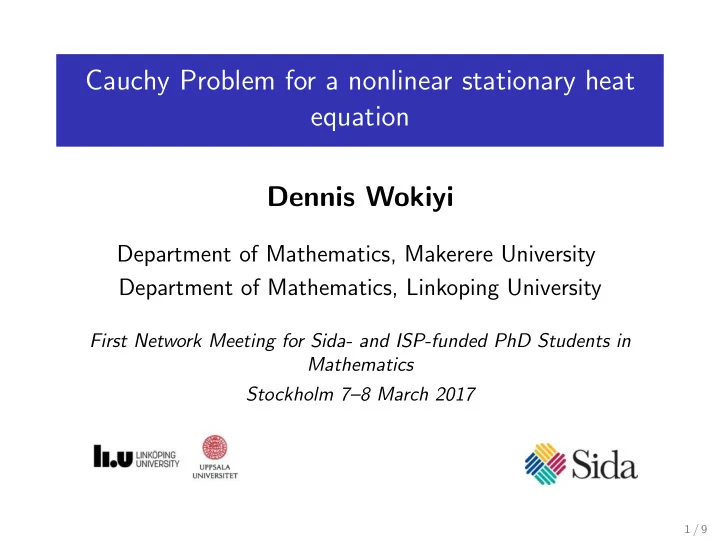

Cauchy Problem for a nonlinear stationary heat equation Dennis Wokiyi Department of Mathematics, Makerere University Department of Mathematics, Linkoping University First Network Meeting for Sida- and ISP-funded PhD Students in Mathematics Stockholm 7–8 March 2017 1 / 9
My Advisors Vildmir Kozlov Fredrik Berntsson John Mango Godwin Kakuba Main supervisor Assistant supervisor Supervisor Supervisor Linkoping University Linkoping University Makerere Makerere 2 / 9
Motivation Elliptic Cauchy problems arise in many aspects of our modern world, that’s, industrial, engineering and biomedical applications which may include Expansion of measured surface fields inside a body from partial boundary measurements Inverse problems related to corrosion detection. Thermostatics problems which consist of recovering temperature in a given domain when its distribution and the heat flux are known over the accessible region of the boundary. In particular we are interested in geophysical prospecting; Definition Thermal Prospecting: This is a system of geophysical prospecting based on measuring underground temperatures/ temperature gradients and relating their irregularities to geological deformation. 3 / 9
Cauchy problem and ill-posedness Consider a two dimensional domain Ω, 4 / 9
Cauchy problem and ill-posedness We formulate the thermal prospecting problem as a Cauchy Problem for a nonlinear stationary heat equation −∇ · ( k ( x , T ) ∇ T ) + p ( x , T ) = 0 , in Ω T ( x , 0) = φ 0 on Γ 0 , (1) kT z ( x , 0) = φ 1 on Γ 0 , where k(x,T) is thermal conductivity function, p ( x , T ) a source term and ( φ 0 , φ 1 ) as the Cauchy data. We assume periodic boundary conditions on Γ 2 and Γ 3 Cauchy problems for elliptic equations are known to be severilly ill-posed in the sense of Hadamard’s definition of wellposedness. According to Hadamard, a problem is wellposed(correctly set ) if it has a solution the solution is unique the solution depends continuously on the data and parameters. 5 / 9
Cauchy problem and ill-posedness Example Consider a two- dimensional Cauchy problem for Laplace equation; � ∂ 2 u ∂ x 2 + ∂ 2 u ∂ y 2 = 0 in Ω := R × [0 , ∞ ) u ( x , 0) = g ( x ) , ∂ u ∂ y ( x , 0) = 0 , ∀ x ∈ R with g ( x ) continuous and bounded. For any n ∈ N , if g n ( x ) := 1 n sin( nx ) for any x ∈ R , then by separation of variables one can easily find the solution u n ( x , y ) = 1 2 sin( nx ) cosh( ny ) ∀ ( x , y ) ∈ Ω . As n → ∞ , g n → 0 uniformly in R and of course u ≡ 0 solves the problem for g ≡ 0. But as n → ∞ , u n does not vanish uniformly in Ω. Therefore this Cauchy problem is ill-posed with respect to the uniform topology. 6 / 9
Solution of the problem The ill-posedness comes about because of absence of the heat flux on the boundary Γ 1 . Note that if we had access to the heatflux at the bottom, then we have a wellposed problem whose solution we can find easily. To strategy of solving the problem is solve instead the direct problem with an arbitrary data on boundary Γ 1 and compare the results with available data on the surface. We reformulate the problem as an operator equation A η = φ 1 (2) where η ∈ X (Γ 1 ), φ 1 ∈ X (Γ 0 ) and X a Banach space; A is a compact operator from X (Γ 1 ) to X (Γ 0 ). It is known that the inverse operator to A if it exists is not continuous hence the problem is ill-posed. Solutions can be obtained using regularization techniques. 7 / 9
Impact and Applications of My Research Who does this research benefit? The results from this research will contribute to the already existing knowledge in this particular area of applied mathematics. My research could also benefit those in the mining and the oil exploration industry. Mineral mapping Prospecting for underground water 8 / 9
Tack s˚ a mycket! Thank you! 9 / 9
Recommend
More recommend